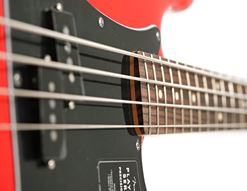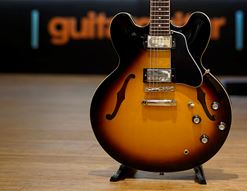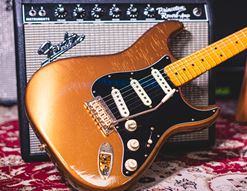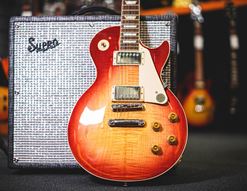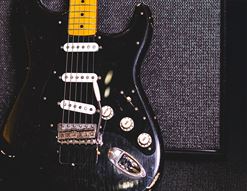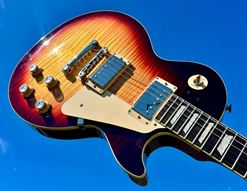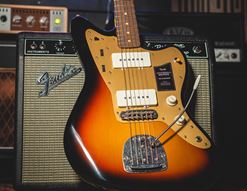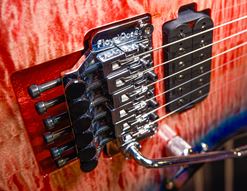The world is full of strange musical instruments. Musical oddities abound in every corner of this fair earth, and I feel like it’s time to shine a light on some of them. Every culture brings forward its own sounds, rhythms and instruments to serve the needs of ritual, religion and recreation.
Today, I’m stretching back in time to find some of the most unusual devices, contraptions and musical doodads that have ever appeared. Whether they are strange takes on familiar themes, practical instruments designed for specific purposes, or entirely new concepts in sound altogether, here are some of the world’s strangest musical instruments…
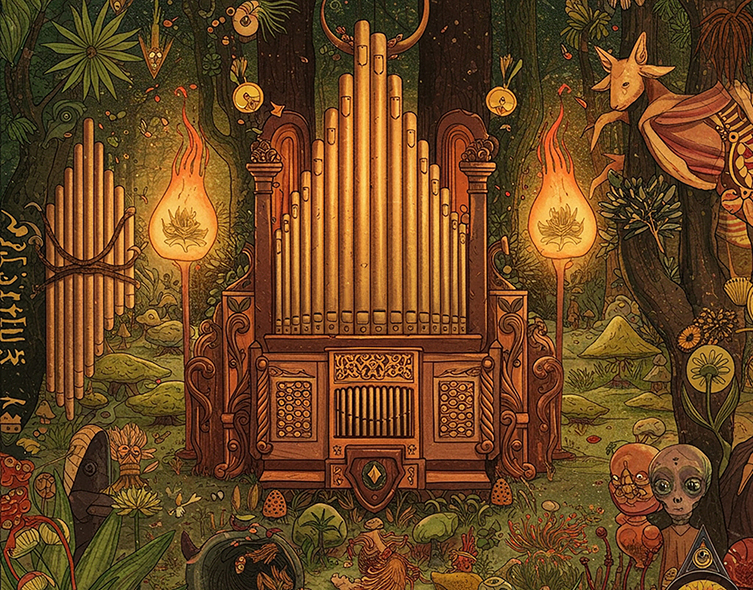
The Instruments at a Glance
Mexican Temple that Sounds like a Birdcall
Pyrophone, the Fire Organ/Explosion Organ
David Byrne Plays an Entire Building
Aztec Death Whistle
Let’s start with something scary, shall we? Have you ever heard an Aztec Death Whistle before? Its formal name is the Ehecachichtli and it is of authentic Mexica origin (the correct term for the civilisation we refer to as Aztec).
Some people reckon that the original aztec whistles sounded pretty normal, but the ones that get everybody’s attention sound like the hellish screams of some sort of demonic monster! Stories abound of them being cursed objects, but that may just be due to the off-putting noises they make.
Were they used in rituals inside the temples, to honour the dead? Were they part of a pre-battle exercise in scaring enemies with their demon-like shrieks? Were they used to help evoke and summon the underworld? No one really knows…
Aztec Death Whistles are shaped like skulls with headdresses these days, but common sense tells me that’s a tourist-baiting decision rather than a historically accurate one. Still, the sound that comes out of these things when you blow into them is high-pitched and unnerving, so obviously buy one as soon as you see one!
Glass Harmonica
The Glass Harmonica - also known as a hydrocrystalophone - is, in simple terms, a fancy version of rubbing your finger on wine glasses. Instead of filling the glasses with water, the Glass Harmonica stacks the glasses inside each other (the size of each glass increases, as does the pitch), and forms a sort of long horizontal playing surface. This is spun by a large wooden wheel, and the player uses the friction from their fingertips to make the pitches from each glass sound.
It was actually invented by American Founding Father Benjamin Franklin, believe it or not! Some reckoned that it had magical powers, with others even believing that it affected the player’s mental health. Some people went as far as calling the glass harmonica ‘the world’s most dangerous musical instrument’, after a child died during a performance in Germany. It was subsequently banned there, out of fear that death and insanity would spread throughout the country whenever the glass harmonica was heard.
Who knows? Maybe they were right!
Waterphone
I first heard about the Waterphone (also known as the Ocean Harp) on a Tom Waits spoken word piece called ‘What’s He Building?’, about a nosy neighbour gossiping about the odd chap living across the street. Since then, the Waterphone has always been the sound of suburban strangeness for me, even though it's actually a pretty exotic looking thing.
It’s an idiophone, which means that its own vibrations create its sound, rather than having strings plucked or electricity sent through it. You have a steel resonator at the base of the unit, from which water is held. Out of this are a number of rods, and these are either bowed or drummed to get a sound.
It’s a very cool, mysterious sound, and even if you don’t recognise it when you look at it, I think you’ll definitely have heard one before somewhere!
Mexican Temple that Sounds like a Birdcall
There are two buildings in today’s blog, and both can be considered musical, in very different ways. This first one is an ancient ziggurat in the Chichin Itza complex in Mexico. This ancient Mayan temple - Kukulcan, part of the Great North Platform - is unique in a great many ways, but the way in which it interests me today is a sonic one.
This old Mayan stepped pyramid can sound like a bird.
As in, it has been designed to perfectly mimic the call of a Quetzal bird, whenever people clap their hands at the foot of the steps. Get a load of this:
Why does the temple have this special ‘musical’ ability built into its structure? I could only guess, but it’s obviously deliberate, and obviously quite incredible. My guess is that the Quetzal bird was named after the Mayan god Quetzalcoatl (I am not an expert on this), and so the temple was designed to sound like the correspondingly named bird, who was known to the Maya as “messenger of the gods”.
But why?
Hydraulophone
The hydraulophone looks superficially similar to the glass harmonica we looked at earlier, except this one uses water flowing over the instrument to get its sound. Actually, you get pitches by blocking holes using hydraulics, and the water striking the instrument creates the tones.
It’s tricky to explain (which maybe means that I don’t properly understand it) so perhaps it's better to check out this performance instead…
Ondes Martenot
How many of you at least recognise the name Ondes Martenot because of Jonny Greenwood? Certainly, the Radiohead guitarist and classical composer is one of the very few well-known musicians to have employed the instrument in recent years.
The Ondes Martenot (pronounced Ohnd Martin-o) is almost a century old, making it one of the world’s oldest electronic musical instruments.
It uses overlapping radio waves to produce a tone, which is then controlled by moving a ring attached to a wire on a keyboard. The effect is similar to a theremin, with the advantage of having at least some visual reference when creating tones. It could be thought of as one of the world’s first synthesizers, too.
Carnyx
If you were a member of the rampaging Roman legions around two thousand years ago, the sound of the carnyx may have been one of the last things you ever heard…
Okay, that was a little dramatic, but this long dragon-headed (or boar-headed) war horn was used by Iron Age Celtic tribes before battles, as their masses hid within wooded hills. The eerie, deathly sound of the carnices would bellow out from behind thickets of trees and unnerve the Roman invaders, who’d never heard such demonic, beastly sounds before. The long necks of the carnyx allowed them to be held vertically, so that their height raised their sound above the clash of battle, allowing them to be heard everywhere.
Pyrophone, the Fire Organ/Explosion Organ
An explosion organ? Really? Yes, this is a real thing, and like many of the ‘more mental’ instruments in today’s blog, this is from the Victorian age.
The things they did for entertainment back then…
So the pyrophone, to give it its proper name, does actually use explosions to make its sound. A series of long tubes extend out of a cabinet that hosts a normal looking keyboard. Hydrogen explosions occur within the bottom area of each tube, and a musical pitch is sounded as part of the explosion. Notes will sustain as long as there is a long enough flame inside the tube.
It all sounds spectacularly dangerous, but you have to admire the ambition here, don’t you? Musical explosions! I genuinely don’t know of another instrument that uses internal combustion as a fundamental part of the sound-making process.
David Byrne Plays an Entire Building
Talking Heads frontman David Byrne may be somewhat self-consciously eccentric, but that doesn’t mean that his activities aren’t worth checking out! For years, he has investigated (not invented, I should make clear) the idea of playing a building as a musical instrument.
The ‘whys’ for this are perhaps beside the point, when the process itself is so fascinating.
‘Playing the Building’ is more of an art installation than an instrument, but let’s not get stuck on details! Byrne basically uses the interior elements of a given building (he’s used a few over the years, in different countries) as resonant tone-producers. From walls to columns and so on, reverberations either come by direct manipulation (hitting stuff) or by passing frequencies along or through them (attaching motors to walls and beams, blowing air at/through surfaces etc).
Nice building, but can you play Oasis on it?
Sea Organ
Here’s another instrument you can’t exactly pack into a case and carry to your next gig. The Sea Organ requires a beach and an ocean, basically. The sea’s naturally occurring waves are used to ‘play’ a series of tubes that sit under a set of marble steps at the edge of the coast. The tones performed will be random but harmonious.
The Sea Organ was created in 2005 by the architect Nikola Basic, and you can find it in Zadar, Croatia. This concept - of using nature itself to make music - is an enduring idea within these more avant-garde areas of music.
Stroh Violin
You’ve definitely seen a Stroh violin before, whether in the hands of buskers or as part of some belle-epoque/vaudevillian stage performance. Does it really qualify for being one of the world’s strangest musical instruments?
Yeah, I’d say so. It’s a violin with a horn attached to the body acting as a loudspeaker. It’s not exactly an everyday object, is it? You might be thinking that violins are plenty loud already - and I’d not rush to disagree - but these appendages really increase the volume!
Stroviol would be the name for the violin model, but such ‘developments’ have been incorporated into viola, cello and other instruments, too. This was created to help violins compete with ever-louder orchestras back in the days before amplification and so on, and the sound itself is quite…unsophisticated, shall we say? Still, it has its own sonic identity and charm, and is now thought of as a particular & special colour of sound to be used when appropriate.
Bowed Saw/Musical Saw
This last one is both very unusual and also quite often-used. A bowed saw is literally that: a long saw (the type you’d use on trees) that you bend to change pitch and bow with a traditional violin bow.
It’s used relatively frequently on Americana recordings, and has a similar effect to a theremin, though more ‘natural’ sounding (that wouldn’t be hard) and slightly more seasick, since it’s difficult to maintain a pitch when the sawblade is always springing and flexing. You use your knees to change pitch, because your hands are already full holding the saw and bowing it!
Check out the middle section of this wonderful Mercury Rev song for a great example of the bowed saw in action…
A World of Sound
There are so many unusual instruments out there, created by eccentric geniuses in a mostly pre-internet age. After checking out Aztec death screams and explosion-powered organs, our humble Strats and SGs seem pretty tame, eh?
Well, there’s a whole world of sounds out there to discover and incorporate into your own music. All it takes is curiosity and an ear for the unusual. Enjoy exploring!

